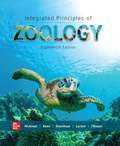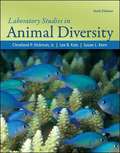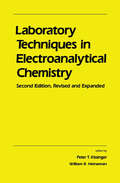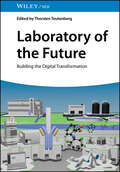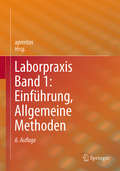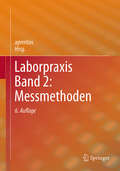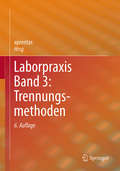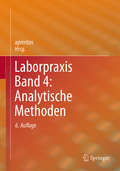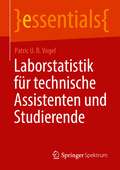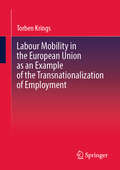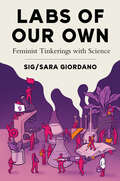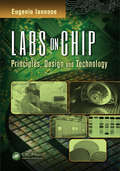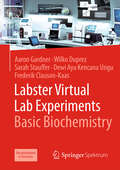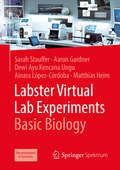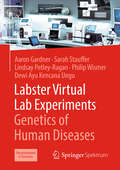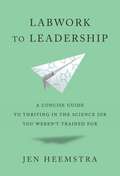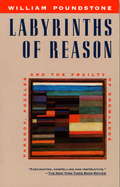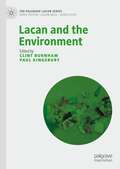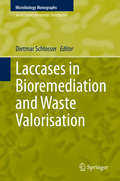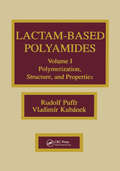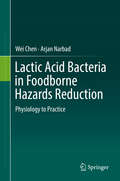- Table View
- List View
Laboratory Studies In Integrated Principles Of Zoology
by Allan Larson Cleveland P. Hickman Larry S. Roberts Helen I'AnsonLaboratory Studies in Integrated Principles of Zoology textbook.
Laboratory Studies for Animal Diversity (Sixth Edition)
by Cleveland P. Hickman Lee Kats Susan KeenLaboratory Studies in Animal Diversity offers students hands-on experience in learning about the diversity of life. It provides students the opportunity to become acquainted with the principal groups of animals and to recognize the unique anatomical features that characterize each group as well as the patterns that link animal groups to each other.
Laboratory Techniques for Fish Disease Diagnosis
by Vikash Kumar Basanta Kumar DasThis book covers various aspects of fish health, disease identification and laboratory procedures. Each section of the book is detailed and includes practical information, step-by-step procedures and relevant illustrations and diagrams. The recent updates on fish disease diagnosis have been incorporated to address new techniques and technologies in the field. Fish disease diagnosis is primarily based on the color and characteristics in the image to target the infected area. It is an indispensable part of modern aquaculture, and rapid and real-time diagnosis is an essential part of the early and precise treatment of the diseases. As farmed fishes are affected by viruses, bacteria, parasites, metal pollution, and fishing damage, accurate disease diagnosis is crucial for effective management interventions. It often requires a combination of clinical expertise, advanced technology, and collaboration among healthcare professionals. This book is a comprehensive guide for students, researchers and professionals involved in fish disease diagnosis.
Laboratory Techniques in Electroanalytical Chemistry, Revised and Expanded
by Peter Kissinger William R. HeinemanThis volume provides a practical, intuitive approach to electroanalytical chemistry, presenting fundamental concepts and experimental techniques without the use of technical jargon or unnecessarily extensive mathematics. This edition offers new material on ways of preparing and using microelectrodes, the processes that govern the voltammetric behavior of microelectrodes, methods for characterizing chemically modified electrodes, electrochemical studies at reduced temperatures, and more. <P><P>The authors cover such topics as analog instrumentation, overcoming solution resistance with stability and grace in potentiostatic circuits, conductivity and conductometry, electrochemical cells, carbon electrodes, film electrodes, microelectrodes, chemically modified electrodes, mercury electrodes, and solvents and supporting electrolytes.
Laboratory Techniques in Plant Bacteriology
by Suresh G. BorkarLaboratory Techniques in Plant Bacteriology is ideal for scientists and students who seek a career in plant pathogenic bacteria. This book contains 41 chapters comprising practicable techniques from isolation of bacterial plant pathogens to their identification up to species and race/biotype level. It includes identification protocols of morphological, biochemical, immunological, and molecular-based techniques. This book comprises all technological aspects of plant bacteriological studies. Its content is ideal for graduate students and research scholars including bacteriological professionals or technicians. The book ultimately provides working technologies useful for controlling bacterial disease pathogens.
Laboratory of the Future: Building the Digital Transformation
by Thorsten TeutenbergAn essential resource for the practical implementation of new technologies in the laboratory value chain In Laboratory of the Future: Building the Digital Transformation, distinguished chemist Dr. Thorsten Teutenberg delivers an up-to-date discussion of digitization and automation, smart workflows, flexible laboratory automation, miniaturization and sustainability in the contemporary laboratory environment. With a strong focus on the practical implementation of the latest technologies and workflows, the book’s intention is to advocate for the digital transformation. Each chapter concludes with various insights from renowned experts in the field, encouraging readers to think critically and deepen their understanding of the presented concepts. These perspectives offer alternative interpretations, highlight the complexity of real-world implementation, and stimulate informed debate. Engaging with diverse perspectives helps readers assess the strengths and limitations of various approaches, fostering a balanced and comprehensive grasp of laboratory digitalization. Laboratory of the Future: Building the Digital Transformation is a valuable resource for laboratory managers, scientists, digital transformation leaders, and decision-makers involved in research and development environments seeking to optimize workflows, enhance data integrity, and implement automation technologies. It offers insights into the future of lab technologies by presenting the challenges and strategies for digitizing laboratory operations and incorporating expert perspectives and practical case studies.
Laborpraxis Band 1: Einführung, Allgemeine Methoden
by AprentasDas vierbändige Standardwerk für die grundlegende praktische Arbeit im chemisch-pharmazeutischen Labor mit Schwerpunkt Synthesemethoden, Chromatographie und Spektroskopie liegt jetzt in der 6. völlig neu überarbeiteten Auflage vor. Es dient Berufseinsteigern als breit angelegtes Lehrmittel und erfahrenen Fachkräften als Nachschlagewerk mit übersichtlich dargestellten theoretischen Grundlagen und konkreten, erprobten Anwendungsideen. Die theoretischen Grundlagen für jedes Kapitel sind gut lesbar abgefasst und unterstützen das Verständnis für praktische Arbeiten und Gerätefunktionen. Zu jedem Kapitel gibt es Hinweise auf vertiefende und weiterführende Literatur. Arbeitssicherheit und –hygiene sowie die zwölf Prinzipien der nachhaltigen Chemie finden neben den entsprechenden Kapiteln Beachtung. Die im Buch erwähnten praktischen Grundlagen gründen auf Gegebenheiten in der chemisch-pharmazeutischen Industrie in der Schweiz. Sie finden im gesamten deutschsprachigen Raum Anwendung, auch in verwandten Arbeitsgebieten wie biochemischen, klinischen, werkstoffkundlichen oder universitären Laboratorien. Die Laborpraxis eignet sich für den Einsatz in der Grund- und in der Weiterbildung von Fachpersonal. Der Inhalt entspricht den aktuellen Anforderungen der Bildungsverordnung und des Bildungsplanes zum Beruf Laborantin / Laborant mit eidgenössischem Fähigkeitszeugnis (EFZ), welche vom Staatssekretariat für Bildung, Forschung und Innovation (SBFI) in Bern verordnet wurden. Damit steht den Lernenden eine gute Grundlage für die Vorbereitung auf das Qualifikationsverfahren (QV) zur Verfügung; Expertinnen und Experten stützen ihre persönlichen Vorbereitungsarbeiten und ihre fachlichen Beurteilungen auf dieses Buch. Band 1 und Band 2 behandeln ausführlich die Grundlagen der Laborarbeit und ausgewählte Messtechniken. Band 3 ist auf präparative und analytische Trennungsmethoden, Band 4 auf nasschemische und spektroskopische Analysemethoden fokussiert. Sowohl konventionelle Methoden als auch modernste Techniken finden Erwähnung. Der Fokus auf beständig gültigen Prinzipien erlaubt auch neue, nicht erwähnte Techniktrends zu verstehen sowie die tägliche Arbeit im chemisch-pharmazeutischen Labor zu reflektieren.
Laborpraxis Band 2: Messmethoden
by AprentasDas vierbändige Standardwerk für die grundlegende praktische Arbeit im chemisch-pharmazeutischen Labor mit Schwerpunkt Synthesemethoden, Chromatographie und Spektroskopie liegt jetzt in der 6. völlig neu überarbeiteten Auflage vor. Es dient Berufseinsteigern als breit angelegtes Lehrmittel und erfahrenen Fachkräften als Nachschlagewerk mit übersichtlich dargestellten theoretischen Grundlagen und konkreten, erprobten Anwendungsideen. Die theoretischen Grundlagen für jedes Kapitel sind gut lesbar abgefasst und unterstützen das Verständnis für praktische Arbeiten und Gerätefunktionen. Zu jedem Kapitel gibt es Hinweise auf vertiefende und weiterführende Literatur. Arbeitssicherheit und –hygiene sowie die zwölf Prinzipien der nachhaltigen Chemie finden neben den entsprechenden Kapiteln Beachtung. Die im Buch erwähnten praktischen Grundlagen gründen auf Gegebenheiten in der chemisch-pharmazeutischen Industrie in der Schweiz. Sie finden im gesamten deutschsprachigen Raum Anwendung, auch in verwandten Arbeitsgebieten wie biochemischen, klinischen, werkstoffkundlichen oder universitären Laboratorien. Die Laborpraxis eignet sich für den Einsatz in der Grund- und in der Weiterbildung von Fachpersonal. Der Inhalt entspricht den aktuellen Anforderungen der Bildungsverordnung und des Bildungsplanes zum Beruf Laborantin / Laborant mit eidgenössischem Fähigkeitszeugnis (EFZ), welche vom Staatssekretariat für Bildung, Forschung und Innovation (SBFI) in Bern verordnet wurden. Damit steht den Lernenden eine gute Grundlage für die Vorbereitung auf das Qualifikationsverfahren (QV) zur Verfügung; Expertinnen und Experten stützen ihre persönlichen Vorbereitungsarbeiten und ihre fachlichen Beurteilungen auf dieses Buch. Band 1 und Band 2 behandeln ausführlich die Grundlagen der Laborarbeit und ausgewählte Messtechniken. Band 3 ist auf präparative und analytische Trennungsmethoden, Band 4 auf nasschemische und spektroskopische Analysemethoden fokussiert. Sowohl konventionelle Methoden als auch modernste Techniken finden Erwähnung. Der Fokus auf beständig gültigen Prinzipien erlaubt auch neue, nicht erwähnte Techniktrends zu verstehen sowie die tägliche Arbeit im chemisch-pharmazeutischen Labor zu reflektieren.
Laborpraxis Band 3: Trennungsmethoden
by AprentasDas vierbändige Standardwerk für die grundlegende praktische Arbeit im chemisch-pharmazeutischen Labor mit Schwerpunkt Synthesemethoden, Chromatographie und Spektroskopie liegt jetzt in der 6. völlig neu überarbeiteten Auflage vor. Es dient Berufseinsteigern als breit angelegtes Lehrmittel und erfahrenen Fachkräften als Nachschlagewerk mit übersichtlich dargestellten theoretischen Grundlagen und konkreten, erprobten Anwendungsideen. Die theoretischen Grundlagen für jedes Kapitel sind gut lesbar abgefasst und unterstützen das Verständnis für praktische Arbeiten und Gerätefunktionen. Zu jedem Kapitel gibt es Hinweise auf vertiefende und weiterführende Literatur. Arbeitssicherheit und –hygiene sowie die zwölf Prinzipien der nachhaltigen Chemie finden neben den entsprechenden Kapiteln Beachtung. Die im Buch erwähnten praktischen Grundlagen gründen auf Gegebenheiten in der chemisch-pharmazeutischen Industrie in der Schweiz. Sie finden im gesamten deutschsprachigen Raum Anwendung, auch in verwandten Arbeitsgebieten wie biochemischen, klinischen, werkstoffkundlichen oder universitären Laboratorien.Die Laborpraxis eignet sich für den Einsatz in der Grund- und in der Weiterbildung von Fachpersonal. Der Inhalt entspricht den aktuellen Anforderungen der Bildungsverordnung und des Bildungsplanes zum Beruf Laborantin / Laborant mit eidgenössischem Fähigkeitszeugnis (EFZ), welche vom Staatssekretariat für Bildung, Forschung und Innovation (SBFI) in Bern verordnet wurden. Damit steht den Lernenden eine gute Grundlage für die Vorbereitung auf das Qualifikationsverfahren (QV) zur Verfügung; Expertinnen und Experten stützen ihre persönlichen Vorbereitungsarbeiten und ihre fachlichen Beurteilungen auf dieses Buch. Band 1 und Band 2 behandeln ausführlich die Grundlagen der Laborarbeit und ausgewählte Messtechniken. Band 3 ist auf präparative und analytische Trennungsmethoden, Band 4 auf nasschemische und spektroskopische Analysemethoden fokussiert. Sowohl konventionelle Methoden als auch modernste Techniken finden Erwähnung. Der Fokus auf beständig gültigen Prinzipien erlaubt auch neue, nicht erwähnte Techniktrends zu verstehen sowie die tägliche Arbeit im chemisch-pharmazeutischen Labor zu reflektieren.
Laborpraxis Band 4: Analytische Methoden
by AprentasDas vierbändige Standardwerk für die grundlegende praktische Arbeit im chemisch-pharmazeutischen Labor mit Schwerpunkt Synthesemethoden, Chromatographie und Spektroskopie liegt jetzt in der 6. völlig neu überarbeiteten Auflage vor. Es dient Berufseinsteigern als breit angelegtes Lehrmittel und erfahrenen Fachkräften als Nachschlagewerk mit übersichtlich dargestellten theoretischen Grundlagen und konkreten, erprobten Anwendungsideen. Die theoretischen Grundlagen für jedes Kapitel sind gut lesbar abgefasst und unterstützen das Verständnis für praktische Arbeiten und Gerätefunktionen. Zu jedem Kapitel gibt es Hinweise auf vertiefende und weiterführende Literatur. Arbeitssicherheit und –hygiene sowie die zwölf Prinzipien der nachhaltigen Chemie finden neben den entsprechenden Kapiteln Beachtung. Die im Buch erwähnten praktischen Grundlagen gründen auf Gegebenheiten in der chemisch-pharmazeutischen Industrie in der Schweiz. Sie finden im gesamten deutschsprachigen Raum Anwendung, auch in verwandten Arbeitsgebieten wie biochemischen, klinischen, werkstoffkundlichen oder universitären Laboratorien. Die Laborpraxis eignet sich für den Einsatz in der Grund- und in der Weiterbildung von Fachpersonal. Der Inhalt entspricht den aktuellen Anforderungen der Bildungsverordnung und des Bildungsplanes zum Beruf Laborantin / Laborant mit eidgenössischem Fähigkeitszeugnis (EFZ), welche vom Staatssekretariat für Bildung, Forschung und Innovation (SBFI) in Bern verordnet wurden. Damit steht den Lernenden eine gute Grundlage für die Vorbereitung auf das Qualifikationsverfahren (QV) zur Verfügung; Expertinnen und Experten stützen ihre persönlichen Vorbereitungsarbeiten und ihre fachlichen Beurteilungen auf dieses Buch. Band 1 und Band 2 behandeln ausführlich die Grundlagen der Laborarbeit und ausgewählte Messtechniken. Band 3 ist auf präparative und analytische Trennungsmethoden, Band 4 auf nasschemische und spektroskopische Analysemethoden fokussiert. Sowohl konventionelle Methoden als auch modernste Techniken finden Erwähnung. Der Fokus auf beständig gültigen Prinzipien erlaubt auch neue, nicht erwähnte Techniktrends zu verstehen sowie die tägliche Arbeit im chemisch-pharmazeutischen Labor zu reflektieren.
Labors of Innocence in Early Modern England
by Joanna PicciottoIn seventeenth-century England, intellectuals of all kinds discovered their idealized self-image in the Adam who investigated, named, and commanded the creatures. Reinvented as the agent of innocent curiosity, Adam was central to the project of redefining contemplation as a productive and public labor. It was by identifying with creation’s original sovereign, Joanna Picciotto argues, that early modern scientists, poets, and pamphleteers claimed authority as both workers and “public persons.” Tracking an ethos of imitatio Adami across a wide range of disciplines and devotions, Picciotto reveals how practical efforts to restore paradise generated the modern concept of objectivity and a novel understanding of the author as an agent of estranged perception. Finally, she shows how the effort to restore Adam as a working collective transformed the corpus mysticum into a public. Offering new readings of key texts by writers such as Robert Hooke, John Locke, Andrew Marvell, Joseph Addison, and most of all John Milton, Labors of Innocence in Early Modern England advances a new account of the relationship between Protestantism, experimental science, the public sphere, and intellectual labor itself.
Laborstatistik für technische Assistenten und Studierende (essentials)
by Patric U. VogelIn diesem essential wird die Anwendung von statistischen Analysen von normalverteilten Daten im Laboralltag dargestellt. Hierzu zählen die Berechnung von Mittelwert und Standardabweichung sowie die Erstellung von einfachen grafischen Abbildungen. Im Anschluss werden Tests auf Ausreißer und Normalverteilung sowie Stichprobenberechnungen anhand einfacher Beispiele vorgestellt. Abschließend erlernen die Leser*innen den Vergleich von Datengruppen mittels t-test und ANOVA, das Erkennen von Zusammenhängen mittels linearer Regression und Korrelation sowie die Anwendung von Konfidenzintervallen. Zusätzlich werden übliche Fehlerquellen bei der Anwendung statistischer Methoden erklärt.
Labour Mobility in the European Union as an Example of the Transnationalization of Employment
by Torben KringsThis book examines the changing significance of intra-European labor mobility in the 21st century. The focus is on the driving forces, the labor market effects and the regulation of this mobility. It is shown that there is a demand for workers with different qualifications in the "post-industrial" societies of Western Europe. This demand is primarily met by migration from the enlarged EU. However, this is no longer traditional labor migration, but the mobility of EU citizens. This brings with it new opportunities, but also challenges in a transnational mobility space, which is also a space of inequality.
Labs of Our Own: Feminist Tinkerings with Science
by Sig / GiordanoFrom climate change to COVID-19 to reproductive justice, there has been deep political polarization around science. Labs of Our Own provides a unique entry point into these twenty-first-century science wars by focusing on our affective relationships to science. The book delves into various sites where scientists, teachers, artists, and activists claim to create more democratic access to science—from DIY biology community labs to feminist classrooms to activist science practitioners. The reader will find that these claims for and attempts at democratic sciences not only impact what counts as science and who counts as a scientist but reconfigure who is included in the proper public. Instead of arguing for a knee-jerk defense of science against right-wing attacks, Labs of Our Own builds the case for a feminist, antiracist, decolonial, queer science tinkering practice that intentionally, politically, and ethically acts to produce new challenges to the definition and boundaries of the human.
Labs on Chip: Principles, Design and Technology (Devices, Circuits, and Systems)
by Eugenio IannoneLabs on Chip: Principles, Design and Technology provides a complete reference for the complex field of labs on chip in biotechnology. Merging three main areas— fluid dynamics, monolithic micro- and nanotechnology, and out-of-equilibrium biochemistry—this text integrates coverage of technology issues with strong theoretical explanations of design techniques. Analyzing each subject from basic principles to relevant applications, this book: Describes the biochemical elements required to work on labs on chip Discusses fabrication, microfluidic, and electronic and optical detection techniques Addresses planar technologies, polymer microfabrication, and process scalability to huge volumes Presents a global view of current lab-on-chip research and development Devotes an entire chapter to labs on chip for genetics Summarizing in one source the different technical competencies required, Labs on Chip: Principles, Design and Technology offers valuable guidance for the lab-on-chip design decision-making process, while exploring essential elements of labs on chip useful both to the professional who wants to approach a new field and to the specialist who wants to gain a broader perspective.
Labster Virtual Lab Experiments: Basic Biochemistry
by Sarah Stauffer Aaron Gardner Wilko Duprez Dewi Ayu Kencana Ungu Frederik Clauson-KaasThis textbook helps you to prepare for your next exams and practical courses by combining theory with virtual lab simulations. The “Labster Virtual Lab Experiments” series gives you a unique opportunity to apply your newly acquired knowledge in a learning game that simulates exciting laboratory experiments. Try out different techniques and work with machines that you otherwise wouldn’t have access to.In this book, you’ll learn the fundamental concepts of basic biochemistry focusing on:Ionic and Covalent BondsIntroduction to Biological MacromoleculesCarbohydratesEnzyme KineticsIn each chapter, you’ll be introduced to one virtual lab simulation and a true-to-life challenge. Following a theory section, you’ll be able to play the relevant simulation that includes quiz questions to reinforce your understanding of the covered topics. 3D animations will show you molecular processes not otherwise visible to the human eye.If you have purchased a printed copy of this book, you get free access to five simulations for the duration of six months. If you’re using the e-book version, you can sign up and buy access to the simulations at www.labster.com/springer.If you like this book, try out other topics in this series, including “Basic Biology”, “Basic Genetics”, and “Genetics of Human Diseases”.
Labster Virtual Lab Experiments: Basic Biology
by Matthias Heim Sarah Stauffer Aaron Gardner Dewi Ayu Ungu Ainara López-CórdobaThis textbook helps you to prepare for both your next exams and practical courses by combining theory with virtual lab simulations. With the “Labster Virtual Lab Experiments” book series you have the unique opportunity to apply your newly acquired knowledge in an interactive learning game that simulates common laboratory experiments. Try out different techniques and work with machines that you otherwise wouldn’t have access to.In this volume on “Basic Biology” you will learn how to work in a biological laboratory and the fundamental theoretical concepts of the following topics: Lab SafetyMitosisMeiosisCellular RespirationProtein SynthesisIn each chapter, you will be introduced to the basic knowledge as well as one virtual lab simulation with a true-to-life challenge. Following a theory section, you will be able to play the corresponding simulation. Each simulation includes quiz questions to reinforce your understanding of the covered topics. 3D animations will show you molecular processes not otherwise visible to the human eye.If you have purchased a printed copy of this book, you get free access to five simulations for the duration of six months. If you’re using the e-book version, you can sign up and buy access to the simulations at www.labster.com/springer.If you like this book, try out other topics in this series, including “Basic Genetcis”, “Basic Biochemistry”, and “Genetics of Human Diseases”.
Labster Virtual Lab Experiments: Basic Genetics
by Sarah Stauffer Aaron Gardner Dewi Ayu Ungu Wilko Duprez Philip WismerThis textbook helps you to prepare for both your next exams and practical courses by combining theory with virtual lab simulations. With the “Labster Virtual Lab Experiments” book series you have the unique opportunity to apply your newly acquired knowledge in an interactive learning game that simulates common laboratory experiments. Try out different techniques and work with machines that you otherwise wouldn’t have access to.In this volume on “Basic Genetics” you will learn how to work in a laboratory with genetic background and the fundamental theoretical concepts of the following topics:Mendelian InheritancePolymerase Chain ReactionAnimal GeneticsGene ExpressionGene RegulationIn each chapter, you will be introduced to the basic knowledge as well as one virtual lab simulation with a true-to-life challenge. Following a theory section, you will be able to play the corresponding simulation. Each simulation includes quiz questions to reinforce your understanding of the covered topics. 3D animations will show you molecular processes not otherwise visible to the human eye. If you have purchased a printed copy of this book, you get free access to five simulations for the duration of six months. If you’re using the e-book version, you can sign up and buy access to the simulations at www.labster.com/springer.If you like this book, try out other topics in this series, including “Basic Biology”, “Basic Biochemistry”, and “Genetics of Human Diseases”.
Labster Virtual Lab Experiments: Genetics of Human Diseases
by Sarah Stauffer Aaron Gardner Philip Wismer Lindsay Petley-Ragan Dewi Ayu Kencana UnguThis textbook helps you to prepare for your next exams and practical courses by combining theory with virtual lab simulations. The “Labster Virtual Lab Experiments” series gives you a unique opportunity to apply your newly acquired knowledge in a learning game that simulates exciting laboratory experiments. Try out different techniques and work with machines that you otherwise wouldn’t have access to. <p><p> In this book, you’ll learn the fundamental concepts of the genetics of human diseases focusing on: <p> Monogenic Disorders - Cytogenetics - Medical Genetics - Viral Gene Therapy
Labwork to Leadership: A Concise Guide to Thriving in the Science Job You Weren’t Trained For
by Jen HeemstraA roadmap for running a lab—and developing the leadership skills you didn’t know you needed.As a graduate student and postdoctoral researcher, chemist Jen Heemstra learned how to collect data, write papers, and give talks to other scientists. But when, just a few years into her first job as a principal investigator, conflict broke out in the lab, she realized there was one skill she hadn’t learned: leadership.Labwork to Leadership is the book that every PI needs. Drawing on her decades of experience—including plenty of trial and error—as well as research from psychology and business management, Heemstra nimbly guides readers through the essentials of scientific leadership. From fostering an inclusive lab environment to setting effective goals and learning to give and receive feedback graciously, she uncovers the curriculum successful PIs must follow to motivate lab members, communicate key values, and inspire confidence.With candor and humility, Labwork to Leadership demystifies the critical leadership skills that too many universities fail to teach. And it shows how teaching scientists to lead can boost productivity, spur innovation, and, above all, help research teams rediscover the joy of science.
Labyrinths of Reason: Paradox, Puzzles, and the Frailty of Knowledge
by William PoundstoneThis sharply intelligent, consistently provocative book takes the reader on an astonishing, thought-provoking voyage into the realm of delightful uncertainty--a world of paradox in which logical argument leads to contradiction and common sense is seemingly rendered irrelevant. (From the Trade Paperback edition.)
Lacan and the Environment (The Palgrave Lacan Series)
by Clint Burnham Paul KingsburyIn this exciting new collection, leading and emerging Lacanian scholars seek to understand what psychoanalysis brings to debates about the environment and the climate crisis. They argue that we cannot understand climate change and all of its multifarious ramifications without first understanding how our terrifying proximity to the real undergirds our relation to the environment, how we mistake lack for loss and mourning for melancholy, and how we seek to destroy the same world we seek to protect. The book traces Lacan’s contribution through a consideration of topics including doomsday preppers, forest suicides, Indigenous resistance, post-apocalyptic films, the mathematics of climate science, and the relevance of Kant. They ask: What can you do if your neighbour is a climate change denier? What would Bartleby do? Does the animal desire? Who is cleaning up all the garbage on the internet? Why is the sudden greening of the planet under COVID-19 no help whatsoever? It offers a timely intervention into Lacanian theory, environmental studies, geography, philosophy, and literary studies that illustrates the relevance of psychoanalysis to current social and environmental concerns.
Laccases in Bioremediation and Waste Valorisation (Microbiology Monographs #33)
by Dietmar SchlosserThis Microbiology Monographs volume covers the latest advances in laccase applications in bioremediation and waste valorisation. The first three chapters provide a comprehensive introduction to fungal and bacterial laccases (the two most important enzyme groups from an application viewpoint) and their practical use in bioremediation and lignocellulosic waste valorisation. Subsequent chapters discuss possible combinations of laccases and further potentially collaborating enzymes, and offer in-depth insights into laccase immobilisation for wastewater treatment and environmental biosensor applications of laccases. Lastly, the book addresses the quest for enzymes with improved and better-fitting properties, covering laccase engineering by directed and computational evolution, and novel enzymes from extreme environments. As such, it is a fascinating read for microbiologists in both industry and academia.
Lactam-based Polyamides, Volume I: Polymerization Structure
by Rudolf Puffr Vladimir KubanekThis two-volume work examines general relationships among the structures, reactivity, and properties of polyamides important for predictions in such fields as materials science. The team of authors, including polymer research chemists, physicists, and specialists in technology and processing, compiled an extensive amount of literature (over 2300 references) to produce two volumes packed with text, tables, drawings, and first-hand information, much of it never before published. Topics include lactams and their production, properties, analysis, theory, and the technology of their polymerization, in addition to polyamides and their processing, modification, analysis, molecular characterization, structure, physical properties, degradation and stabilization, designing and application of products. Researchers and specialists in the preparation, modification, processing, structure, and properties of linear aliphatic polyamides will find Lactam-Based Polyamides, Volumes I and II to be invaluable texts.
Lactic Acid Bacteria in Foodborne Hazards Reduction: Physiology to Practice
by Wei Chen Arjan NarbadThis book provides an overview of the physiological basis of lactic acid bacteria and their applications in minimizing foodborne risks, such as pathogens, heavy metal pollution, biotoxin contamination and food‐based allergies. While highlighting the mechanisms responsible for these biological effects, it also addresses the challenges and opportunities that lactic acid bacteria represent in food safety management. It offers a valuable resource for researchers, graduate students, nutritionists and product developers in the fields of food science and microbiology.
